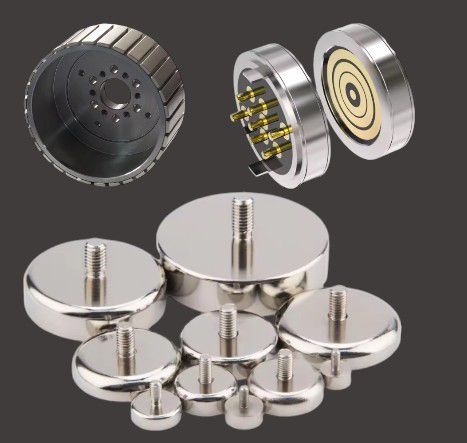Magnet Assembly: A Comprehensive Overview
Introduction
Magnet assemblies are integral components in a wide range of applications, from industrial machinery and consumer electronics to medical devices and renewable energy systems. These assemblies combine magnets with other materials and components to create systems that harness and control magnetic forces for specific purposes. This comprehensive overview explores the different types of magnet assemblies, their applications, design considerations, manufacturing processes, and emerging trends in the field.

1. Types of Magnet Assemblies
Magnet assemblies can be broadly categorized based on the type of magnet used and the specific application. Common types include:
– Permanent Magnet Assemblies: These use magnets that generate a consistent magnetic field without the need for an external power source. Neodymium (NdFeB), Samarium Cobalt (SmCo), and Ferrite (Ceramic) magnets are commonly used in these assemblies.
– Electromagnet Assemblies: Unlike permanent magnets, electromagnets generate a magnetic field when an electric current passes through a coil of wire wrapped around a magnetic core. These assemblies are used in applications where the magnetic field needs to be switched on and off or varied in strength.
– Halbach Arrays: A special arrangement of permanent magnets designed to enhance the magnetic field on one side of the array while canceling it on the opposite side. Halbach arrays are often used in applications requiring a strong, directed magnetic field, such as in magnetic levitation systems.
– Hybrid Magnet Assemblies: These combine different types of magnets or integrate magnets with other components, such as sensors or mechanical parts, to achieve specific functional objectives.
Stanford Magnets specializes in the production of high-quality magnetic assemblies, tailored to meet the unique requirements of each application. Leveraging decades of expertise, Stanford Magnets offers a wide range of assemblies, including Halbach arrays, motor components, and custom solutions. Send us an inquiry for advanced magnetic solutions.
2. Applications of Magnet Assemblies
Magnet assemblies are used across various industries due to their ability to perform diverse functions. Some key applications include:
– Aerospace and Defense: Magnet assemblies are used in navigation systems, sensors, and actuators, where reliability and performance under extreme conditions are crucial.
– Automotive Industry: In electric vehicles, magnet assemblies are essential for motors, generators, and regenerative braking systems. They are also used in sensors and actuators throughout the vehicle.
– Consumer Electronics: Magnet assemblies are found in hard drives, speakers, microphones, and various other components of electronic devices.
– Medical Devices: MRI machines, surgical tools, and drug delivery systems all rely on specialized magnet assemblies to function effectively and safely.
– Renewable Energy: Wind turbines and other renewable energy systems use magnet assemblies in generators to convert mechanical energy into electrical energy efficiently.
3. Design Considerations
Designing a magnet assembly requires careful consideration of several factors to ensure optimal performance:
– Magnetic Field Requirements: The strength, direction, and uniformity of the magnetic field must be tailored to the specific application. This involves selecting the appropriate type of magnet and configuring the assembly to achieve the desired field characteristics.
– Mechanical Constraints: The physical dimensions, weight, and mechanical properties of the assembly must align with the application’s requirements. This is particularly important in aerospace and automotive industries, where space and weight are often limited.
– Thermal Management: Many applications involve high temperatures that can affect a magnet’s performance. Selecting magnets with appropriate temperature ratings and incorporating cooling mechanisms are critical for maintaining functionality.
– Corrosion Resistance: In environments where the assembly is exposed to moisture or corrosive substances, protective coatings or corrosion-resistant materials are necessary to ensure longevity.
– Cost and Material Availability: The cost-effectiveness of the assembly must be balanced with performance requirements, taking into account the availability of materials, particularly rare earth magnets like neodymium.
4. Manufacturing Processes
The manufacturing of magnet assemblies involves several advanced techniques to ensure precision and durability:
– Precision Machining: CNC machining and other precision methods are used to shape magnets and components to exact specifications. This ensures that the assembly functions as intended with minimal loss of magnetic efficiency.
– Laser Cutting and Welding: These processes are used for cutting and joining materials with high precision, which is particularly important for maintaining the integrity of the magnetic properties during assembly.
– Additive Manufacturing: Also known as 3D printing, this technique allows for the creation of complex geometries and rapid prototyping of magnet assemblies, enabling quicker iterations and customization.
– Powder Metallurgy: Used in the production of bonded magnets, this process involves compressing magnetic powders into a desired shape, offering flexibility in creating magnets with specific properties.
– Coating and Surface Treatments: To protect magnets from corrosion and wear, various coatings such as nickel, epoxy, and PTFE are applied. Advanced methods like PVD (Physical Vapor Deposition) provide thin, uniform coatings that enhance durability.
5. Emerging Trends
As technology advances, new trends are shaping the future of magnet assemblies:
– Miniaturization: The demand for smaller, more powerful devices is driving the development of miniaturized magnet assemblies. This is particularly relevant in consumer electronics and medical devices.
– Smart Magnet Assemblies: Integration of sensors and electronics into magnet assemblies is leading to the development of “smart” systems that can adjust their magnetic properties in response to environmental changes or specific commands.
– Sustainability and Recycling: With increasing concern over the environmental impact of rare earth magnet production, there is growing interest in developing sustainable manufacturing practices and recycling processes for magnet assemblies.
– Advanced Materials: Research into new magnetic materials, such as high-entropy alloys and nanocomposites, promises to enhance the performance and reduce the cost of future magnet assemblies.
Conclusion
Magnet assemblies are vital components in a wide array of modern technologies, and their importance is only growing as new applications emerge. The successful design and manufacture of these assemblies require a deep understanding of magnetic principles, materials science, and advanced manufacturing techniques. As industries continue to innovate, magnet assemblies will undoubtedly play a key role in shaping the future of technology.